

United Methodist ChurchVan Wert, Iowa |
||||||||||||||||||||||||||
 |
||||||||||||||||||||||||||
| Auction Sale of M. E. Church at Van
Wert, Saturday, Jan. 10. |
||||||||||||||||||||||||||
| The Leon Reporter Leon, Decatur County, Iowa Thursday, January 01, 1914 On next Saturday afternoon at 1:30 the [original wooden frame] Methodist church building at Van Wert will be sold at public auction to the highest bidder. Also, a No. 5 Keith's floor furnace will be offered. The building is a frame 26x54 of white pine material. Terms of sale made known on ground. Possession to be given about Feb. 20th or sooner if possible, and building to be removed by purchaser by April 1st, 1914. H. O. Tuttle, Secretary. Transcription by Sharon R. Becker, March of 2015 |
||||||||||||||||||||||||||
| Methodist Church | ||||||||||||||||||||||||||
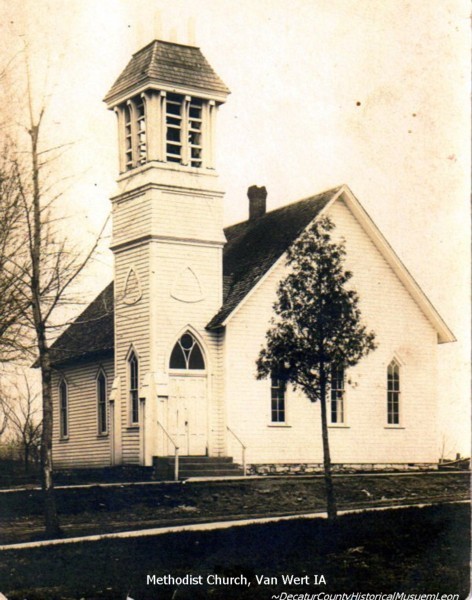 A
Century of Memories" of Van Wert, Iowa A
Century of Memories" of Van Wert, Iowa1880 - 1980, Pp. 39-42 The following information has been taken primarily from the History Sketch of the Methodist Episcopal Church printed for the Dedication Day on March 22, 1914. The reason it is for the most part copied directly from this book was because it included any and all information we could gather in the years prior to 1956 and then some besides. Obviously, it was impossible to include word for word everything contained in the book but we have done our best to include all facts and figures. Later information has been obtained from church records and newspaper clippings and word of mouth. The Methodist Church of Van Wert was organized, as nearly as we can ascertain, in the year of 1856. For some time previous to this, services were held in town by ministers of whatever denomination perchanced to come by. In those pioneer days, all were heard most gladly. Probably the fact that the Methodist Ministers itinerated so largely led to them being first on this field. The following is a list as complete as we can make it of the charter members of the church: James Blair, Louise Blair, Carlos Clark, Mrs. Carlos Clark, Nathan Perdue, Mary Perdue, Newton Spencer, Lucinda Jane Spencer, William Warner, and Lovina Warner. Within a few years after the organization was effected, the dream of those faithful few was realized in a substantial church building. This building was erected amid sacrifice and joy in 1858. The site chosen for the church was just a little way south of the railroad on the west side of what is now Main Street, there being no railroad there at this time. Before its completion the little body of worshipers gathered for service in the old school building. The material used in the construction of the church was principally native lumber. Everybody seemed anxious for a church and so all hands contributed to its erection. Some hauled logs to the sawmill and had them sawed into 2x4's and other heavy building material; some hauled walnut logs and had them sawed for siding, while others made shingles. The work of construction as well as the material was chiefly donated. It is reported the Rev. Talmage, then pastor of the little congregation, donated much work. To understand the intensity of the enthusiasm we need only to be reminded that this faithful expounder of the word and pounder of the nail had only one arm and hand yet he drove the nails with accuracy and speed. In that early day of toil, sacrifice and want, we would expect that the furnishings of the church would be rather crude to our modern ideas. A donation of shingles kept the roof from being unfinished. For three years the walls were unplastered. The seats were of heavy planks laid across dry goods boxes. It was for ten or a dozen years before these were replaced by the carefully prepared walnut seats. A highly prized historic relic is found in these old walnut seats made in the sixties (one was secured and placed in the basement of the 1914 church for safekeeping). The church was more perfect in durability than comfort. The Reverend William Brown did the casing of the building in 1863. The founding fathers of the church were poor people come west to get a start in life. They brought Methodism because they loved the church and Methodism loved the poor. There were few farmers here then who had more than five to ten acres of prairie sod broken. Considering all things they did marvelously well to build at all. For their sacrifices we owe much, and to their labors of love, we ascribe the beginnings of Methodism here. The following pastors have served the church, as near as can be ascertained in the order given: |
||||||||||||||||||||||||||
|
||||||||||||||||||||||||||
| For many years the church realized a good growth, and this
growth so increased that it was found necessary in 1888 to build a
larger and more commodious building. Through the foresight of the Rev.
Seth Samson, a local elder, the present site was obtained. Mr. Samson
found that these lots could be purchased for the reasonable amount of
$70.00. He consulted with the Board and he was advised to buy the lots.
This he did by paying for them by himself, and leaving his purchase with
the members to reimburse him as they saw fit. In the final accounting,
the church paid about one-half the total amount and Rev. Samson paid the
balance. Rev. Samson also built the first Methodist Parsonage. The lot and house owned by the church at this time was sold for $150. For years, the building was used as a store building, and it was burned during the west side fire in September 1908. During these two years the church membership rented the upper room of the public school building and they held regular services there. Within two years, the building was provided for an erected. It was dedicated Nov. 11, 1888, by the venerable presiding elder, Rev. W.C. Martin. The total cost of the property, including the lots was $1,719.25. It was at the time of this signal victory that Rev. Samson wrote in the subscription book, "To God be all the Praise." The building thus dedicated in 1888 was of the following dimensions: 28 feet by 45 feet. Some years later an eight-foot alcove, located back of the pulpit, was built on the north end. For twenty-six years this church building served the need of the congregation. During these years the Van Wert congregation had been associated with the following circuits: Decatur City, Hopeville, Green Bay and Weldon. In 1897 the Rev. F.P. Sigler organized the Van Wert Circuit, which was composed of Van Wert, Lacelle and Fairview. Lacelle was later dropped from the circuit and Fairview and Van Wert then supported a minister. Pastors here given have been ministers of the church from 1888 to 1913: |
||||||||||||||||||||||||||
|
||||||||||||||||||||||||||
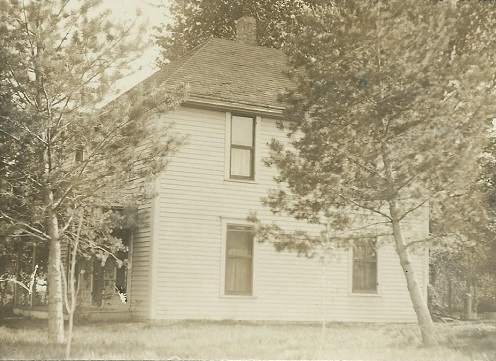 The
parsonage located across the street to the south of the church, was made
the property of the church during the pastorate of the Rev. J.W.
Caldwell. It was remodeled during the pastorate of Rev. R.J. Tennant, at
a cost of some $600. The parsonage property consisted of one lot, on
which there was a good house and other small buildings. The
parsonage located across the street to the south of the church, was made
the property of the church during the pastorate of the Rev. J.W.
Caldwell. It was remodeled during the pastorate of Rev. R.J. Tennant, at
a cost of some $600. The parsonage property consisted of one lot, on
which there was a good house and other small buildings.In May 1910, the Methodist choir presented a cantata, "Ruth the Gleaner", with Alma Garber, A. E. Blair, Mrs. Garber, Susie Davis, Forrest Allen and the Mourners, Reapers and Gleaners. To follow the growth and demands of the congregation throughout the years would require more space than is here allotted. It is asking too much, also, to trace in detail the first movements and earliest demands for the new church building. For years the cry of the people most closely associated with the work of the church has been for better facilities afforded only by more room. The question whether to repair or remodel or build anew was debated through the months and even years. To remodel the old building, and, thus, obtain room for every need, would require hundreds of dollars; to build entirely new would demand thousands. Gradually the idea of an entirely new building gained favor. By August 25, 1912, the new-church talk had taken on sufficient enthusiasm that Rev. J. Branson, Pastor, thought the time was ripe to begin the preparation for building. His idea seemed to have been to popularize the movement by enlisting the largest number possible, and especially the young people, in the enterprise. Accordingly, as the records show, he took the matter up in a regular Sunday service, and appointed a soliciting committee, also a building committee: The soliciting committee, composed of the following: A.E. Blair, E.N. Hampton, Mrs. Cora Belding, E.E. Walker, Izora Heather, Mrs. G.D. Tallman, Grace Keller, A. Standbrough, Mrs. D.E. Tuttle, Mrs. C.F. Fierce, and Mrs. S. Jennings, began the canvass of the community for funds to erect a new building. As the autumn months came on, the work of the committee ceased. We find no records of further meetings after Oct. 14, 1912. The matter was taken up again in the early summer of 1913. On May 9, Rev. Martin H. Keast, whose pastorate began in March, called a meeting of the trustees, at which time the board was organized and the following officers were elected: president, E.E. Stearns; secretary, H.O. Tuttle, treasurer, J. Stearns. The attention of the board of trustees was called to the need of a new church. The question was thoroughly threshed out, and it was decided to at once begin plans for the erection of a new modern brick church building to cost from eight to ten thousand dollars. The soliciting committee had gathered $2,000 before ceasing their work. Then again later took up the work and pushed it to completion. The building committee was A.E. Blair, E.J. Blair, F. Binning, J.C. Fierce, A.B. Riche, E.O. Stearns, H.O. Tuttle and C.C. Waters. At a meeting on July 12, 1913, sealed bids for the erection of the new church were taken, with Teas Brothers of Chariton winning by a unanimous vote. At the same meeting it was decided to use dark colored pressed brick below the water table and a light gray colored pressed brick above the water table to be trimmed in Bedford Stone. The work of excavating began in July of 1913. Teams of horses and workmen arrived at an early hour and president of the board of trustees, E.O. Stearns, steadied the first scraper and began the work of excavating. |
||||||||||||||||||||||||||
| Click on
the link to see an enlarged view of the photograph. Click on "back button" to return to this webpage. |
||||||||||||||||||||||||||
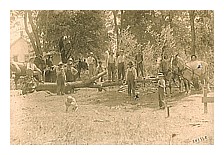 |
 |
|||||||||||||||||||||||||
| Taking down trees | Clearing the land | |||||||||||||||||||||||||
 |
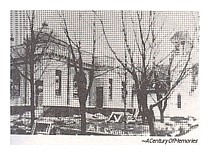 |
|||||||||||||||||||||||||
| Clearing the land | Final construction | |||||||||||||||||||||||||
| The Leon Reporter Leon, Decatur County, Iowa Thursday, October 10, 1913, Page 1 |
||||||||||||||||||||||||||
| CORNER STONE LAYING ____________ Of the Magnificent New $10,000 Methodist Church at Van Wert on Friday October 3rd. |
||||||||||||||||||||||||||
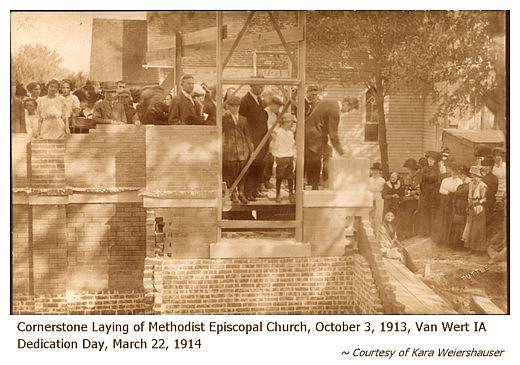 |
||||||||||||||||||||||||||
| The formal laying of the corner stone of the new
Methodist Episcopal church at Van Wert will be observed Friday, October
3rd, promptly at 2 p. m. Some prominent ministers are expected to be
present and an appropriate program will be rendered. A cordial
invitation is extended to all to attend this service. Work on the building is being pushed very rapidly for it is to be completed by December 1st and dedicated about January 1st. The Methodist society at Van Wert is in excellent working condition and has made a remarkable growth during the past half century; beginning as it did in a small frame building of rough native lumber with rough board benches for seats they have been faithful to their charge. The old native building gave way to a better frame building, in keeping with the times and requirements of the society, in 1888, but this, of late, is being crowded and in its stead the new modern building is being erected. The new church is being constructed of hydraulic pressed brick and Bedford stone, surmounted by a large copper dome, with windows and dome light of especially designed art glass. The full seating capacity will be nearly 500 people which will be all the room needed for many years to come. Under it all is a modern basement for Sunday school class work and social functions; provided with kitchen, serving, dining and retiring rooms. The Methodist Society at Van Wert is fully alive to the needs of the times and is doing real progressive Christian work in all church lines, in a modest way that does not have to be sounded with a trumpet to be understood. Methodist are not given to make "much ado" about what they are doing but are deepest concerned about the real spiritual things that count most for Christianity. There is nothing being cheapened nor omitted in the construction of the new building, but quality and durability are the first considerations, then convenience and beauty in both the building and its furnishings which, when completed will cost approximately $10,000. The help and encouragement from the church's many friends in this new undertaking is fully appreciated by them and they solicit a continuation of this same spirit throughout all time. Transcription by Sharon R. Becker, March of 2015 |
||||||||||||||||||||||||||
| The Leon Reporter Leon, Decatur County, Iowa Thursday, October 10, 1913, Page 1 |
||||||||||||||||||||||||||
| CORNER STONE IS LAID | ||||||||||||||||||||||||||
| Van Wert Methodist Held
Impressive Ceremonies In Laying Corner Stone of New Church |
||||||||||||||||||||||||||
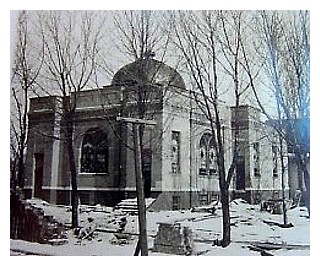 Friday,
October 3rd was the corner-stone laying of the beautiful new church at
Van Wert. People were present from far and near. The service began at 2
o'clock and lasted a little over an hour. The public school dismissed
for the occasion, and the pupils and teachers attended in a body, adding
cheer to the occasion. Friday,
October 3rd was the corner-stone laying of the beautiful new church at
Van Wert. People were present from far and near. The service began at 2
o'clock and lasted a little over an hour. The public school dismissed
for the occasion, and the pupils and teachers attended in a body, adding
cheer to the occasion.The Rev. Dr. Holmes gave the principal address. He was at his best and brought a great message to the throng of people. Dr. Thompson, the district superintendent, was also present, and had a message of cheer. Other ministers present were Rev. Boyer, of Osceola, Rev. Fansher, of Leon, Rev. Hawk, of Grand River, Rev. Cunningham of Decatur. These ministers had part in the beautiful ritual, as found in the Methodist Dicipline, for the occasion. The corner stone had many papers and documents which will be of interest to future generations. The building is of brick, and modern throughout, so it will be many years barring accidents, before the contents of this stone will be seen again. Rev. Martin H. Keast placed items in a small metal box, those of which included such things as a Bible, church and Sunday School up to date information, and various county papers and Christian papers. The cornerstone located on the Southwest corner bears the inscription: M.E. Church 1856-1913 and is also made of Bedford Stone. There were many present at this service who helped to build the old frame building. These and all the membership are proud to see this beautiful building being rapidly prepared for worship. The contractors are hard at work, and the building will be done on schedule time. Methodism will see greater things here as this house of worship is equipped. The signs of the times are favorable. Transcription by Sharon R. Becker, March of 2015 |
||||||||||||||||||||||||||
| The Leon Reporter Leon, Decatur County, Iowa Thursday, March 12, 1914 |
||||||||||||||||||||||||||
| New Van Wert M. E. Church will be Dedicated Sunday, March 22nd. | ||||||||||||||||||||||||||
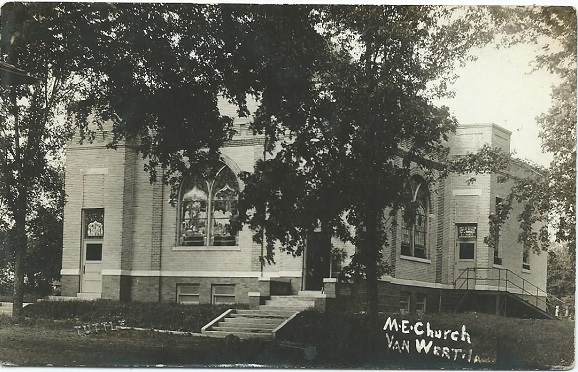 |
||||||||||||||||||||||||||
| The splendid new M. E. church at Van Wert will be
dedicated on Sunday, March 22nd. President E. A. Schell, D. D., of Iowa
Wesleyan, will be the principal speaker. It will be an all day service
commencing with a sermon by Dr. Schell at 10 a. m. A basket dinner will
be held in the new basement, and fraternal services at 3 o'clock. At the
evening service sermon will be by Dr. Schell. A cordial invitation is
extended to everyone to attend the dedication. Transcription by Sharon R. Becker, March of 2015 The new building measured 46x62 feet. The roof was given a six-ply tar preparation roof with a coat of hot tar and gravel on top of that to serve as a weather protector of the entire tar preparation. The dome was constructed of heavy number one lumber and entirely covered with copper. Copper was chosen over tile because the same endurance could be obtained with less burdensome weight. The furnace was made by Campbell Furnace Co. of Des Moines, the lighting system installed by the same company that put lights in the old church, the Incandescent Light Co. of Cincinnati, Ohio. This lighting was a gas system but the church was wired for electricity as well. The pews were made by the American Seating Co. of Chicago, Ill. from oak timber grown in Wisconsin. The art glass was purchased from Flanagan & Bienewil Co. of Chicago, Ill. with Mr. Geity as the efficient designer. The general conviction is that the beautiful windows in the west end, ("The Good Shepherd," John 10: 1-16) is unsurpassed by any ever seen in a building of equal cost and size. The following memorials and gift windows appear in the church: In the main entrance of the auditorium the window bears the inscription "Saved for Service" and was donated by the women's Foreign Missionary Society of the local church. The Sunday School window is half of the large window in the south wall of the building. Its appearance was made possible through funds contributed by the Adult Bible Class and the Sunday School. The emblem design is the Sunday School flag surrounded by the red circle adopted as the badge of the Adult Bible Class movement. Newton and Lucinda Jane Spencer's relatives donated a window for their memory. The Epworth League, located back of the pulpit, is the gift of the young people. Rev. Seth Samson gave both a gift and memorial window in memory of his wife, Margaret. James and Louise Blair are listed among the names of this section although their specific gift was not mentioned. The G.A.R. window is located in the vestibule at the northwest corner of the church and is the gift of the Old Soldiers of the local camp. |
||||||||||||||||||||||||||
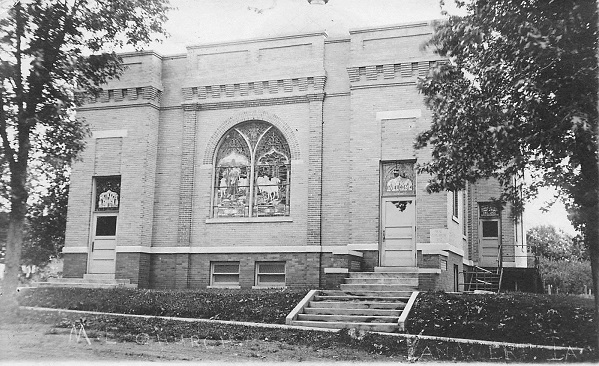 |
||||||||||||||||||||||||||
| The Masonic window seems to place emphasis on the
brotherly love idea taught in the Bible. The bees buzzing around a beehive emblem is the Ladies Aid Society gift, and truly symbolizes the ladies work. Mrs. Stearns' class of boys saved an offering, starting long before any visible evidence of a new church was seen, so that they could donate a window. "Walter Hampton, 1904-1911" is the inscription on the window given by Mr. and Mrs. E.N. Hampton as a memorial to their dear son. Mr. E.O. Stearns' Young Men's Bible class also saved money so that they might give a window. Besides their window, many personal gifts were given as well. The Branson-Keast window, located in the back end of the pastor's study was assigned as a gift to the former pastor and wife and incumbents in recognition of humble service rendered. The window located on the north side of the pastor's study is a memorial of Jonathan and Carrie Stearns. When the new church was built in 1914, 106 families were represented among the 218 members. Several clubs and organizations were a part of the church body then. The Epworth League was active in both the spiritual and social life of the community and numerically, Van Wert's club led in the Chariton District. The Junior League was reorganized in September 7, 1913 by Mrs. Keast, who was appointed superintendent, and the group met every Sunday at 2:30 p.m. for Bible study, and memory work. During that time, the group is said to have grown from 8 to over 50. The Ladies Aid Society is composed of the ladies of the church and is the only group still active in the church today. They meet monthly and are responsible for most of the fund raising events The Women's Foreign Missionary Society met in monthly sessions, and donated approximately $100 per month toward the support of missionaries when in existence. The Young Women's Missionary organization was known as the Standard Bearers. They met monthly and were carefully "mothered" by the W.F.M.S. president. Rev. O.W. Morrow was the first minister in the new church. Those following him were: J.A. Walls, Virgil Henderson, I.S. Selby, J.A. Walls, Murdock Neeves, Malcom Love, C. Horton Tally, A.J. Bissinger, James Buikema, Oliver Jensen, Myrtle Wolf (Cox), Lucius L. Smith, W.M. Harkin, William Miller, W.M. Andre, Laurence Garrett, Howard Adams, James Wilkins, Tom Murr, Harold Nichols, Paul Deny, Alan Ricks, Judy May, Lyle Dunham, Cecil Latta, Dan Neininger and Bradley Waller. Today the pastors are Robert Bell (the first two Sundays each month) and Leroy Perkins (the last two Sundays each month). Approximately 20 to 25 members attend the church today. In May, 1943, the church windows were damaged quite badly by a windstorm. The large window on the south was completely damaged. Luckily, none of the memorial windows were damaged. The large dome on the church was removed on account of the weight and causing the roof to leak. An article appearing in the Leon paper on March 24, 1949 tells us that the first boards of the old parsonage were torn off on September 21, 1948. Men donated labor and razed the old building salvaging lots of old lumber for the new parsonage. $3,000 cash was donated toward the new parsonage as well as $2,000 in labor. The little house was all modern with five rooms, a bath, and a full basement. The Ladies Aid purchased a new gas stove and installed venetian blinds throughout the house. (There is a slight discrepancy evident here wherein the article from Leon paper tells us a new gas stove was purchased and the historical book of the church says it was a new electric refrigerator.) The ladies held penny suppers and food sales and served at various auctions to get money to help with the new parsonage. Al Redman donated all the sand used. Elmer Kivett served as building chairman and the rest of the committee was made up of Ralph Lamoree, Al Redman and Mrs. Owen Bulkeley and Mrs. George Redman. Mrs. Jesse Redman was the secretary-treasurer. Virgil Simmerman (Weldon) was the head carpenter assisted by Wesley Goff (Weldon), Herman Brown (Van Wert) and Paul Simmerman (then of Van Wert); Kenneth Mitchell (Garden Grove) did all the plastering while Ivan Corsbie did all the wiring. On March 1, 1949 the pastor and his wife moved in. |
||||||||||||||||||||||||||
 |
||||||||||||||||||||||||||
| Back row: Sherry (Price) Balow 2nd from left; Linda (Price) Anderson 3rd from left. | ||||||||||||||||||||||||||
 |
||||||||||||||||||||||||||
| Included
are: Mrs. Lewis, Wilbur Richey, Mrs. Kinett, Harry Blair, Effie Argabright, Bassech Mallett, Charley Woodall, Fannie Hall, Charley Runes, Clark France, Mrs. Hirett |
||||||||||||||||||||||||||
| In September 1956 (photo above) the church
celebrated Methodism's 100th birthday in our community. A great many
turned out for the events that day. In 1970 extensive remodeling was done in the basement. a new kitchen was built and new tables and chairs were purchased for the dining area. On Easter Sunday, April 18, 1976, a worship service center was donated in memory of the late Ivan Corsbie. Items dedicated were an altar, drapes, a lighted cross and paraments for Corsbie. Vicki Adams, granddaughter, and friend, Ron Leeper, dedicated the song, "The Three Nails" in Ivan's memory. The Rev. Judith May presented Mrs. Corsbie with a certificate of dedication. Many family members and friends attended. Contribution courtesy of Larry McElwee, Dodge City, Kansas, mcelwee42@cox.net; updated by Sharon R. Becker, July of 2015 |
||||||||||||||||||||||||||
| Click on
thumbnail photo to see an enlarged view of the photograph. Click on "back button" to return to this webpage. |
||||||||||||||||||||||||||
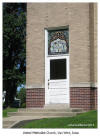 |
 |
 |
 |
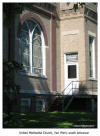 |
||||||||||||||||||||||
| Van Wert's United Methodist Church was designed by
architect O. A. [Oran Alonzo] Hougland. He was born September 6, 1859 in
Missouri. He came to Chariton, Iowa, in 1876 and began a career as a
carpenter, builder and contractor. At the turn of the century, 1900, his
career as an architect boomed. He designed many buildings in Chariton
and the Lucas County Home. He was the architect of Chariton's First
Presbyterian Church which was built in 1909 and dedicated in February of
1909. Corning's First Methodist Church, also was of his 1908 design. In
1910, seven churches were in various stage of construction, all using
his designs - Promise City, Humeston, Carlisle, Milo, Clearfield, Grand
River and Van Wert. Of these churches, the Milo Church burned in 1921;
Clearfield Church has been demolished; Humeston and Grand River churches
have been demolished, too; Diagonal's Church has been torn down and
replaced. The church at Promise City still (2010) stands but has been
closed and most of the interior work has been removed. Van Wert's United Methodist Church continues to thrive. O. A. Hougland died suddenly on August 8, 1912, while in Lenox shortly after signing a contract to design a hotel there. He was interred at Chariton. SOURCES: "Death of O. A. Hougland." The Chariton Leader, Chariton IA. Aug. 15, 1912. charitonsd.blogspot.com/2012/04/architects-oran-alonzo-hougland.html lucascountyan.blogspot.com/2012/04/lon-houglands-churches.html?m=1 Compiled by Sharon R. Becker, March of 2015 |
||||||||||||||||||||||||||
| Church Index * Decatur County IAGenWeb | ||||||||||||||||||||||||||